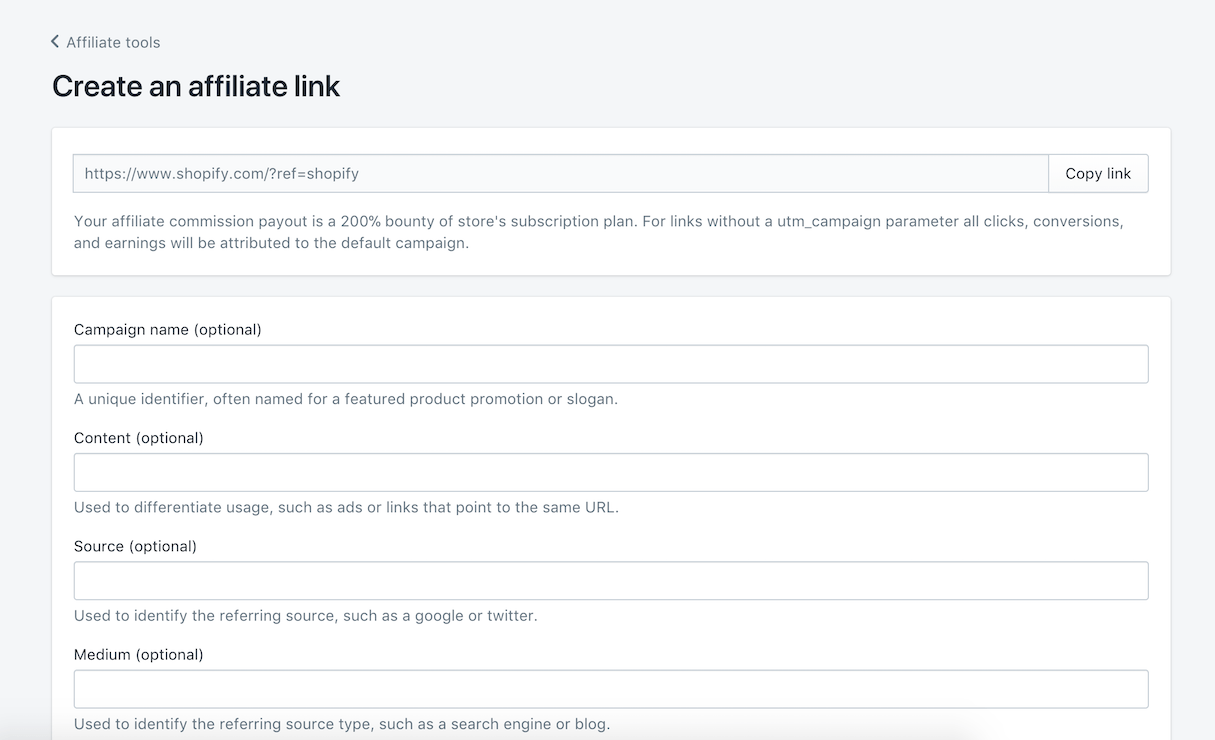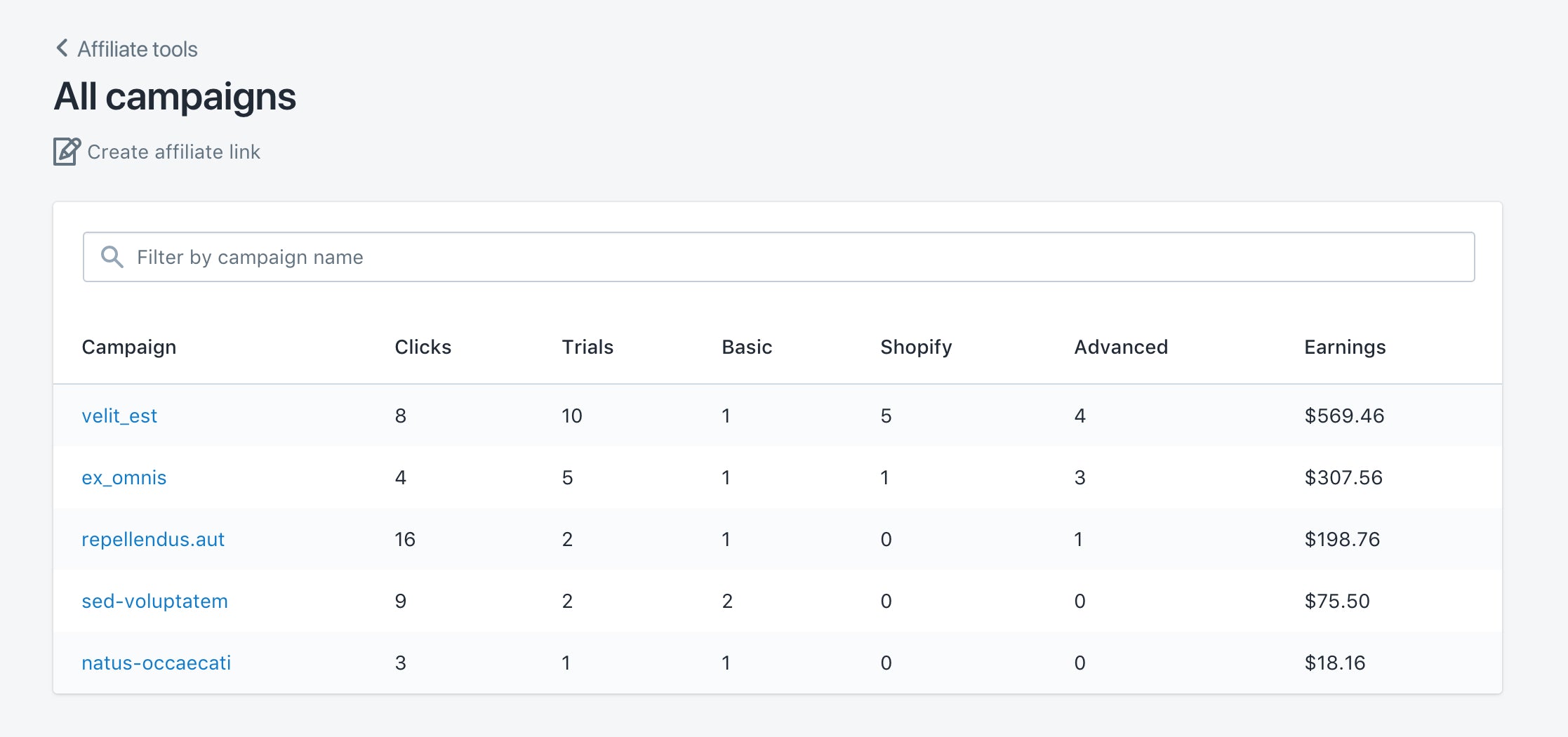As a Shopify Affiliate, it’s important that you have the tools you need to measure the success of your marketing efforts. You might have questions, like:
- Is your affiliate link getting clicks?
- How many referrals is it driving?
Or, if you’re using an external performance marketing tool:
- Which campaigns have been most successful?
- Which campaigns should be deprecated?
- What channels should you focus your efforts on?
Well, wonder no more. Today we’re announcing new, powerful Affiliate tools that approved Shopify Affiliates can start using right away.
Now, you’ll not only be able to create robust campaign links with tracking parameters like campaign and sub ID, but you’ll also be able to monitor their performance (including conversions!) — all within the Affiliate tools section of your Partner Dashboard.
6 New affiliate link parameters
Traditionally, to deeplink to Shopify content using your affiliate link, you’d append ?ref=yourhandlehere to the end of a shopify.com URL (i.e. If you wanted to link to Shopify’s pricing page, your link would be https://www.shopify.ca/pricing?ref=yourhandle).
With the introduction of campaign links, you’ll now be able to add six new parameters to your affiliate link: campaign, content, source, medium, and sub ID (1 and 2). This additional data will help you understand which deeplinks are creating the best results for your initiative, as well as which outreach platforms are driving the most traffic and conversions.
Similarly to how digital marketers use UTMs to track their marketing and advertising campaigns, or how affiliate marketers use performance marketing tools like HasOffers, the create affiliate link function in the Affiliate tools section of your dashboard will help you track all of your Shopify referral efforts.
But before we learn how to build these powerful new affiliate links, let’s break down each of the six new parameters so you can get the most out of your tracking.
You might also like: 5 of the Best Prototyping Tools to Test Out Your Web and Mobile Designs.
1. Campaign
Campaign is a unique identifier that allows you to group your affiliate links based on a common theme, like a featured product promotion or a marketing campaign slogan. Campaign is similar to how you’d use the campaign parameter in a Google Analytics UTM — something that helps you quickly and easily understand the purpose of the link.
For example, if you run a promotional campaign in the summer that speaks to Shopify’s pricing, your campaign parameter might look like this:
summer-pricing-2018
Or if you run a winter campaign talking about Shopify POS, you might use the following campaign name:
winter-pos-2018
(Note: When naming each parameter, words should always be separated by an dash — or - — character.)
The campaign parameter will help you understand which promotions are most effective in terms of conversions and traffic.
2. Content
Content is used to label the creative, or use case, of each link if you have multiple links pointing to the same Shopify page. You’d use content similar to how you’d use the content parameter in a Google Analytics UTM — to differentiate between similar content in the same campaign.
For example, going back to our summer pricing idea, if your campaign is summer-pricing-2018 and you have two separate promotions running at the same time, your content parameter might be promo-1 and promo-2.
More specifically, if your summer pricing campaign were promoting the Basic Shopify plan and the Advanced plan separately, but both linked to the general pricing page, your content might be more detailed, like shopify-basic and shopify-advanced.
The content parameter will help you identify which creative executions are resulting in the most conversions. If shopify-basic is underperforming compared shopify-advanced, you might consider deprecating it and focusing your efforts on more shopify-advanced content.
3. Source
The source parameter identifies where your affiliate link was posted, or where the traffic is coming from. Source is similar to how you’d use the source parameter in a Google Analytics UTM.
Let’s say you’re promoting the Shopify Advanced portion of your summer pricing campaign on your personal blog, your source would be personal-blog.
But what if you’re promoting the Shopify Basic portion of your campaign in an ecommerce training course on YouTube? Then your source would be youtube.
Using the source parameter for your affiliate links will help you better understand which channels are working best in terms of traffic and conversions.
4. Medium
Medium is similar to source in that it helps you identify where the affiliate link was posted, but instead of being very specific to the channel name, it refers to the channel type. You’d use medium similar to how you use the medium parameter in Google Analytics.
Since the source of your Shopify Advanced summer pricing campaign is your personal-blog, your medium would be something like website.
As for your Shopify Basic promotion, since your ecommerce training course lives on YouTube, which is a social media platform, your medium would be social.
5. & 6. Sub ID 1 and Sub ID 2
Do you need additional information to get the most out of your affiliate link? This is where subid comes in. Sub IDs are custom parameters used to dynamically store and track unique attributes, like where your link might appear within your blog post, if it’s in one training course and not the rest, or if you want to track a unique user.
For example, going back to your ecommerce training course on YouTube, you might want to specify which course the link appears in.
In this case, you’d use the subid parameter to specify that it’s actually your ecommerce-for-beginners course that promotes the Shopify Basic portion of your summer pricing campaign.
You might also like: 4 Affiliate Marketing Strategies to Sell More in Any Market.
Putting everything together
Let’s look at a complete example of how all of these parameters work together for your summer pricing campaign:
Affiliate link #1: Your Shopify Advanced promotion on your blog
-
Campaignissummer-pricing-2018. -
Contentisshopify-advanced. -
Sourceis yourpersonal-blog. -
Mediumiswebsite. -
Subidisin-post-CTA.
Affiliate link #2: Your Shopify Basic promotion in your ecommerce course
-
Campaignissummer-pricing-2018. -
Contentisshopify-basic. -
Sourceisyoutube. -
Mediumissocial. -
Subidisecommerce-for-beginners.
Note: You don’t need to use all of the parameters when creating your affiliate link. Only use those relevant to your campaign.
Creating robust affiliate links
Now that you understand the new components that can be added to an affiliate link, let’s walk through how to generate your first campaign link.
Don’t worry, we’ve made it easy — all you need to do is fill in the blanks on the create affiliate link page of your Partner Dashboard.

Here’s how to do it:
- Navigate to the Affiliate tools section of the Partner Dashboard.
- Click create affiliate link.
- Add all of your required parameters (campaign, content, medium, sub ID).
- Click Copy link.
Ta-da! Easy peasy.
Once you start using your campaign link, data will be reflected under the Affiliate tools section of your Partner Dashboard within 2 hours.


Affiliate link best practices
With great power comes great responsibility.
Now that you’re able to generate insightful affiliate links that will help you better understand where your Shopify referrals are coming from, there are a few things to keep in mind:
1. Always disclose your relationship with Shopify
Like all affiliate programs, every time you use your affiliate link you should be open and honest about your working relationship with Shopify.
2. Don’t use paid advertising to directly promote your affiliate link
You can use paid advertising to promote your own content, which contains your affiliate link, like a blog post where you talk about starting an ecommerce business, but you can’t directly send traffic to your Shopify affiliate link through your paid efforts. This also means you can’t compete on Shopify branded keywords in your other promotional efforts.
You might also like: Content Monetization: How it Works and Mistakes to Avoid.
3. Position yourself as a thought leader
Make sure that the content you’re producing to promote your affiliate link is adding extra value to your followers, and isn’t just a plug for your link. Think: Free website audit, a white paper, a course on how to run Facebook ads for a Shopify store, etc.
Better tooling to help you get the most out of your affiliate link
With the ability to create robust affiliate links and visually see the results of your campaigns, you can enjoy a more intuitive Partner Dashboard that supports the logistics side of your Shopify Affiliate efforts.
We’re confident that these updates will help you better calculate the ROI of your performance marketing campaigns, and more proactively plan the growth of your business. 🙂
Read more
- How to Grow Your Affiliate Marketing Efforts: Develop an Audience-First Paid Media Strategy
- How To Create a Successful Educational YouTube Channel for Your Business
- How to Generate Leads for Your Business Using Content
- 7 Tips to Help Cultivate Authenticity for your Affiliate Marketing Business
- Always Listen to Mo: How Mohamed Ali Aguel Became an Ecommerce Education Superstar
- How Christoph Filgertshofer Became Germany's 18-Year-Old Affiliate Marketing Wunderkind
- 4 Tips to Help You Create a Profitable Affiliate Blog Post
Testing out these new dashboard features? Let us know what you think in the comments below!

